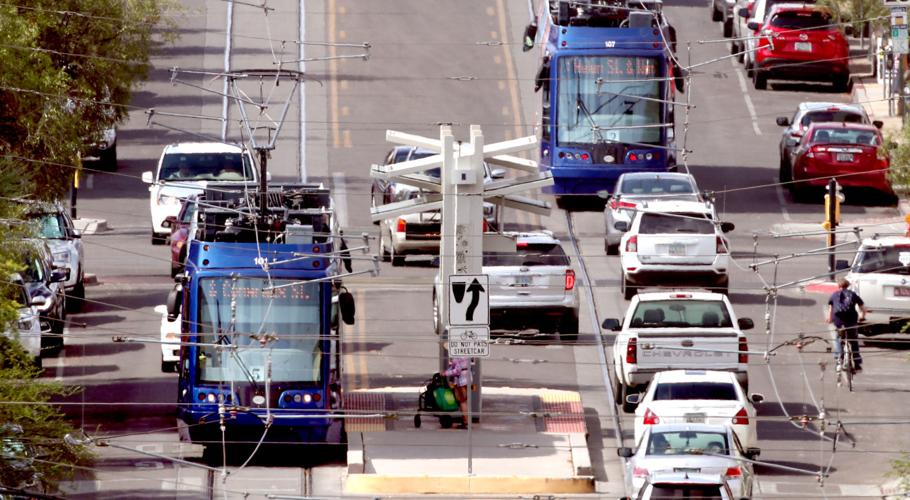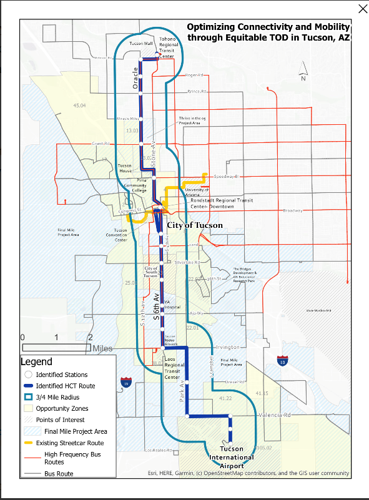The city of Tucson is seeking a federal grant to help further its plans for a 15-mile, high-capacity transit line to take residents from Tucson International Airport to the Tucson Mall area.
The Tucson Department of Transportation is planning to construct infrastructure solely dedicated to streetcars or trying its hand with a rapid-transit bus line in an area recognized for its high bus ridership.
The two largest portions of the route run through South Sixth Avenue and Oracle Road, passing downtown as it snakes north to the mall. Transit stops would be placed a half-mile to a mile apart.
It would also link Tucson’s three regional transit centers —Tohono T’adai, Roy Laos and Ronstadt — according to Jennifer Toothaker, a project manager with the department’s planning and programming division.
“If we were to be awarded this grant, we would use that (Federal Transit Administration) money to fund studies that would look at the market around the proposed line, looking at what currently exists there in terms of housing and businesses and what opportunity sites might be great initial investments,” Toothaker said. “And what might be financing tools to allow the city to help build mixed-income, mixed-used, transit-oriented developments.”
Officials are seeking around $2 million from the FTA’s Transit-Oriented Development Program to accomplish this goal.
“We see that there are areas along these segments that have not only redevelopment potential but there’s the potential that we would be displacing communities that have lived in this area for generations,” Toothaker said.
At least one of the neighborhood associations within the study area shares the same concerns about the project. According to Michael Ray, who lives in the Limberlost Neighborhood, the main concerns center on losing other modes of transportation.
“We’re really wanting to try and calm traffic and the hope would be by putting in multi modes of transportation, like the streetcar, that you get more people out of their automobiles and into other modes of transportation. What we’d hope not to see is increased congestion and traffic on Stone Avenue,” Ray said.
“In the funding of it, we would want to see that pedestrian access to the mall, for instance, be improved and gentrification is a real concern for us as well.”
The three-year plan could go either way, but the public can expect to be able to give input about the department’s plans.
Extending Tucson’s streetcars
Officials have long praised the building and use of the $197 million Sun Link Streetcar line since its 2014 launch.
Sun Link says it has connected riders to “major activity centers,” including the University of Arizona and downtown.
And it could be a sign of things to come for the proposed 15-mile transit line.
Along the current streetcar’s 4-mile route, 100,000 Tucson residents live only a half-mile away, according to the Sun Link website.
At capacity, a streetcar can seat 148 passengers compared with about 40 on a Sun Tran bus.
The streetcar has also helped spur investment, with more than 50 new restaurants, bars and cafes placed along the route, along with a host of business expansions, Sun Link said.
“The streetcar has been a major player in the complete rebirth of the downtown area, Fourth Avenue, Main Gate Square, the Mercado area ... all seen tremendous growth in the last six or seven years, even a little bit more time than the streetcar’s been around,” said Pat Richter, a spokesman for Sun Link.
“By those standards, the streetcar is a tremendous success.”
Making way for Bus Rapid Transit
A rapid-transit bus line could be a less-costly option than extending the streetcar route, according to Arthur C. Nelson, professor of Urban Planning and Real Estate Development at the University of Arizona.
Nelson, who’s studied rapid-transit bus systems around the nation since 2011, says the bus line would also provide larger transportation capacity and increased accessibility for residents along the route.
“An alternative, if you do it right, is to create a bus rapid-transit system that is comprised of dedicated traffic lanes for the buses, signalized intersections so that as the buses approach them, they get the automatic right of way so there’s no stopping at the intersections,” Nelson said. “The stops themselves are roughly a half-mile or longer between them so they’re not stopping every block or every other block.”
He said the clean-emission buses would pull up to the elevated platforms for easy rider access, have displays with accurate bus arrival times and paying for rides would be completed at each stop.
“If you do it right, they can be attractive landmarks for the real estate market in a particular area and by being attractive and providing a safe and convenient access throughout the system. Bus rapid transit can attract and improve employment opportunities and also residential opportunities.”
Nelson said Tucson can learn from other cities’ trials and errors to conduct proper citizen-engagement opportunities and successful methods of designing high-capacity transit lines.
He said the streetcar is a success and those transportation experiences should be built upon or Tucson may be left behind compared with other regions.
“The way our urban real estate markets are going, metropolitan areas that don’t have well-designed, well-functioning, higher-end transit systems will be left in the dust.”
Down the Road
Send feedback to ADOT about I-10, Barraza-Aviation project: ADOT will be accepting public comments about the proposed project until Dec. 12.
You can send your comments by:
- Visiting azdot.gov/i10SR210study
- Calling the toll-free study hotline at 1-888-692-2678
- Emailing i10SR210Study@hdrinc.com
- Mailing comments to ADOT Community Relations, 1221 S. Second Ave., Tucson, AZ 85713






